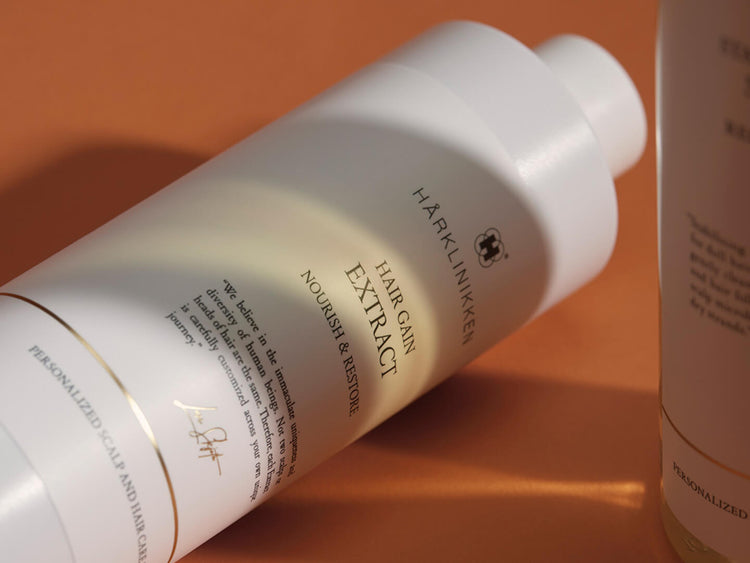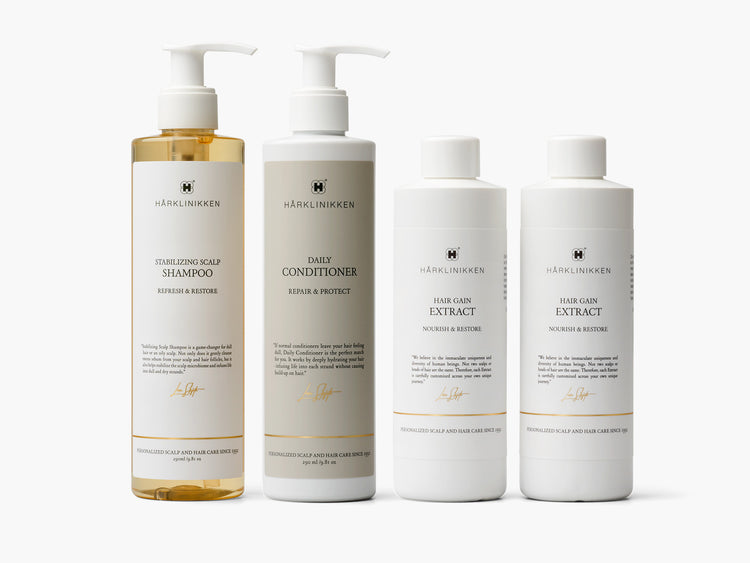Seasonal changes affect us all. As daytime extends and temperatures rise, we notice changes in our bodies, too. More sunlight means more vitamin D, spring blooms mean allergies, and longer days mean a disrupted circadian rhythm. Another biological change we may see is an increased amount of hair shedding.
Do seasonal changes trigger hair loss?
According to the American Academy of Dermatology Association, it is considered normal to shed around 50 to 100 hairs per day if you have normal to healthy hair density. If you have very few hairs or are already dealing with hair loss, then losing 50 to 100 a day can be a problem. Anything above that can count as increased hair shedding. And as it turns out, seasonal hair loss is a real phenomenon. While the exact mechanisms behind it are still not fully understood, both anecdotal reports and scientific studies support the idea that people may experience increased hair shedding during certain times of the year.
Many notice a higher amount of hair loss during the fall or spring months, which has prompted researchers to investigate potential explanations for this seasonal pattern.
The natural hair growth cycle
One prominent theory is that seasonal changes may affect the hair growth cycle, particularly the telogen phase. Hair goes through a natural cycle consisting of three phases:
- Anagen (growth): lasts 2 to 8 years
- Catagen (transition): lasts a few days
- Telogen (resting): lasts 3 to 4 months
Telogen is the final stage of the hair growth cycle when the hair follicle is no longer active. Normally, about 5% to 15% of the hairs on the scalp are in the telogen phase at any given time. However, during seasonal hair loss, this number may temporarily increase.
Environmental factors
Outside of the natural hair growth cycle, we can also point to environmental factors. These factors can be attributed to changes in temperature, humidity, and exposure to sunlight.
Environmental factors such as reduced sunlight exposure and colder temperatures during the transition from summer to fall, could also potentially trigger more hairs to enter the telogen phase. When this happens, a person might notice a change in hair texture and oil production as an immediate response to changes in their environment. This can result in a temporary increase in hair shedding a few weeks or months later.
During warmer months, if you happen to blast your air conditioner, your hair can also see changes in its texture and hydration–becoming more brittle and dry. This also applies to the wintertime if you have your heater on at all times.
Lifestyle changes
We can also account for the lifestyle and behavioral changes that come with seasonal transitions like changes in diet, hairstyling, or even stress levels.
Telogen effluvium
Stressors or lifestyle changes in certain times of the year can lead increased hair loss, also known as telogen effluvium. Telogen effluvium is a sudden, diffuse shedding of hair, often triggered by a stressful event, illness, or significant shift in routine. Seasonal changes, like the stress of returning to school, work, holidays, or even travel, can potentially trigger this type of hair loss.
Thus, seasonal hair shedding is a type of telogen effluvium.
Seasonal hair loss vs. genetic hair loss
Seasonal hair loss is temporary
Seasonal hair loss is typically temporary and self-limiting, which makes it distinct from more chronic or medical forms of hair loss. Unlike genetic or autoimmune types of hair loss, seasonal shedding is usually not permanent and often resolves on its own without medical intervention.
It’s important to find out what type of hair loss you’re experiencing. Many blame their shedding on seasonal hair loss when they are in fact experiencing gradual hair thinning and miniaturization.
Signs your hair loss may be seasonal:
- Shedding increases during specific times of the year (e.g., fall or spring).
- Hair falls out diffusely all over the scalp rather than in specific areas.
- There are no noticeable changes in scalp visibility or density over time.
- The shedding tends to subside after a few weeks to a couple of months.
If your hair meets these conditions, the loss is more likely temporary and linked to seasonal or stress-related triggers.
Genetic hair loss is permanent
Genetic hair loss includes conditions like androgenetic alopecia (also known as male or female pattern hair loss), which is largely hereditary and tends to progress over time. This type of hair loss typically presents as thinning at the crown or hairline in men and diffuse thinning over the top of the scalp in women.
If your shed hairs are being replaced by hairs with smaller diameter shafts, i.e., skinnier/thinner hairs, this is where your increased shedding is also hair thinning. Although there are several conditions that can cause this, this is most commonly seen in individuals who have an androgenetic predisposition.
Another form, alopecia areata, is an autoimmune condition that results in sudden, patchy hair loss and may require more intensive treatment. These conditions have very different causes and courses than seasonal hair shedding.
When to be concerned and seek support:
- You notice thinning at the hairline or crown that persists or worsens over time.
- Shed hairs appear significantly thinner or shorter than usual (a sign of miniaturization).
- You observe widening parts, receding hairlines, or patchy bald spots.
- The shedding continues for more than 2–3 months without improvement.
- There's a family history of pattern baldness or autoimmune conditions.
If you notice these signs, it’s worth consulting a professional to rule out underlying conditions and explore treatment options early.
Find the root cause
First, determine if you are losing more hair than usual. Then, determine the underlying cause of hair loss before jumping to conclusions or starting treatments.
If someone experiences hair loss, especially if it seems excessive or is accompanied by other symptoms, consulting with a healthcare provider or dermatologist can possibly help clarify whether the shedding is seasonal, stress-related, or due to an underlying medical issue. Identifying the correct type of hair loss is key, as each type may require a specific approach to management and treatment.
If you do feel that you are dealing with seasonal shedding or even androgenetic hair loss, take a quick hair assessment to see which clean, science-backed formulas can help restore your scalp microbiome and hair health.
We offer a hair growth serum that is a topical custom-blended formula to suit each individual’s needs that can help to restore hair quality, scalp health, and even reverse hair thinning if it isn’t too far progressed.
How to deal with seasonal hair loss
If you deal with seasonal hair loss around the same time of year, every year, it’s time to address your lifestyle, environment, stress-level, and hairstyling habits as thoroughly as you can.
Maintain a healthy diet
Make sure to eat a well-balanced, nutrient dense diet to ensure that you get a broad variety of vitamins, minerals, fatty acids, and protein as hair health is also linked to your overall health and wellness. It can also be useful to visit your healthcare provider to determine your nutritional deficiencies, as they may directly impact your hair health and density.
Nourish your scalp
Scalp is skin, too, and we should give it as much care and attention as we do with facial skin. Seasonal changes like the transition from winter to spring can disrupt your scalp microbiome due to excess sweat or buildup during the warmer months. It’s important to clean your scalp daily or every other day with a cleansing yet nourishing shampoo to support the health of your hair follicles.
It is equally important to hydrate your lengths with a conditioner or hydrating mask that is silicone and paraben-free to strengthen your strands.
Manage your stress-levels
Stress is one of the biggest triggers for temporary hair loss. It’s important to find healthy ways to manage your stress levels, be it through exercise, better sleep, meditation, or journaling.
Always remember that seasonal hair loss is not permanent. If you recently noticed more hair shedding than usual, don’t stress. It won’t last forever. Address the changes that come with the seasons and always care for your scalp, no matter what time of year it is.

Unsure where to start?
We only accept candidates who we believe we can help, which is why our online Hair Assessment is the best place to start. Based on your results, you will either qualify for immediate treatment or we will organize a consultation.






